Amongst world of rapidly changes preferences, unpredictable trends, and shifting consumer confidence there is one thing that remains consistent across all human species – our craving for conserving energy. Put bluntly, consumers want to move less.
“Consumers want to move less, think less and receive more.”
Winning innovations are less about price or value but about who can make people move less. Amazon is reducing clicks, Siri is eliminating arm movements, Uber is removing steps and Apple is minimizing eye ball movements. How are you appealing to our inner laziness?

SHIFTING THE FOCUS TO ENERGY, NOT CONVENIENCE.
Let’s not confuse energy with convenience. Convenience is an individual specific, subjective interpretation of our return on time. Whereas, energy is a universal, biological and objective need to conserve energy. Conserving energy and convenience can certainly co-exist (they are not mutually exclusive), but understanding the distinction between them is critical for future innovation…To make this distinction crystal clear consider the following examples…
- We may drive around a parking lot to find a closer parking spot when more distant spots are available (waste time to walk less).
- We often are willing to wait for elevators instead of the stairs which often are quicker/convenient.
- During Uber peak times, people still choose Uber over cabs paying more and even waiting to not have to walk more and find a cab.
- We use a cart (instead of basket) when only grabbing a couple of items at the grocery store.
HOW-TO INNOVATE BY REDUCING ENERGY COSTS.
Innovating on energy is about reducing the physical energy demands of our body during purchasing and experiencing products and services. Innovating on energy can be achieved in two ways: 1) Reduce gross motor movements, and 2) Reduce fine motor movements.
1 Gross motor movements are what most think of when reducing bodily movements. They are whole body movements that require larger muscle groups (e.g., open a door, walk down stairs, carrying bags). How can we reduce the amount of walking, squatting, carrying, lifting in the path to purchase and experiencing a product?
2 Fine motor movements the small precise movements that engage small muscles for coordinated actions (e.g., zip zippers, writing, tie shoes, hold spoon, brush teeth, open container, etc.). How can we reduce the amount of arm bending, mouth chewing, head rotating, finger swiping, and eye ball movements?

By taking an “energy lens” rooted in reducing biological movement, we can gain an unrivaled perspective on why technology is taking off and provide new means for innovation.
FOCUS ON FINE-MOTOR MOVEMENTS
While most “energy reducing” innovations target reducing gross “whole body” motor movements, the small “fine” motor movements may offer a more attractive opportunity for innovation. Why? Because small coordinated, repetitive “fine” motor movements are annoying to perform. They take longer to develop, require more coordination, increased attention, and more awareness. Whereas, gross “total body” movements are typically performed without awareness so innovating on them may not be perceived by consumers.
- Amazon Alexa. Amazon is the best at understanding consumers craving for being lazy. They get the value of removing clicks in addition to removing costs. Alexa is a game-changing innovation in energy reduction, by reducing both gross and fine motor movements. Digital voice simply removes the need for typing, moving arms, and walking in many of daily activities. It’s amazing how I can order food, shop online, check the weather and turning on the lights from my couch.
- Insta-cart. Insta-cart removes the entire grocery shopping experience making it an innovation in removing gross body movements. Definitely a huge saver in time and energy, but may not appeal to everyone as it removes the experience all-together. Amazon new stores
- Amazon Go-Store. In contrast to removing the entire grocery shopping experience (which offers pleasure for many customers), Amazon Go-Store is removing the annoying fine motor movements associated with the shopping experience (checking out, standing in a line, opening your wallet).
- Nike Self-Lacing Shoes. Tying shoes is not hard nor does it require lots of energy, but just enough to be annoying. Nike recognized this by innovating a self-lacing system that ties your shoes for you (HyperAdapt 1.0). They also are working on single hand lacing system (FlyEase).
- Apple Face Detection. The iPhone X Face detection merits little attention from a security perspective, but is undoubtedly a major innovation in reducing fine motor movements. Thanks for saving me the additional thumb movements.
- Control Screens with Eyes. A significant advancement will be leveraging eye tracking technology to replace computer mice and finger movements to control digital screens, apps and computers.






